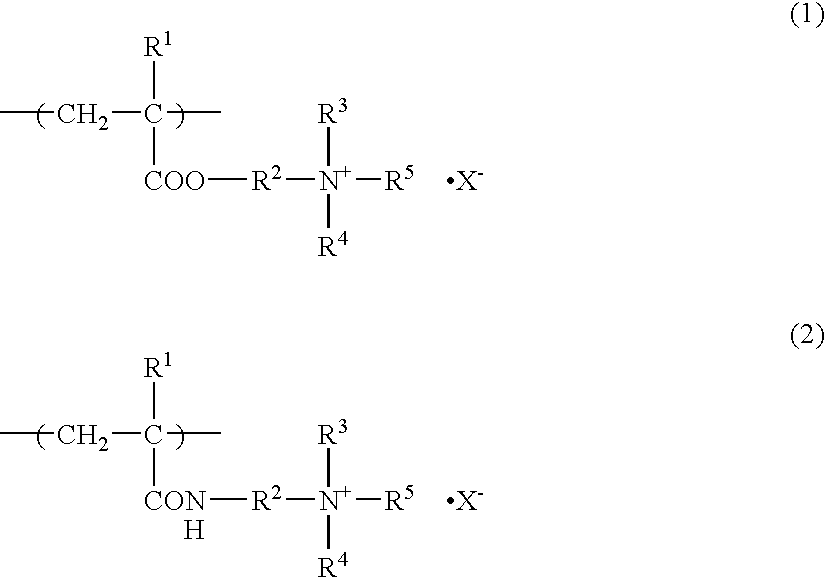Positively charged developer for development of electrostatic image and production process thereof
a technology of electrostatic image and developer, applied in the direction of developers, instruments, optics, etc., can solve the problems of insufficient environmental stability, insufficient toners, easy to fail clean, etc., and achieve the effect of good cleaning ability, not impaired printing properties, and easy to clean
- Summary
- Abstract
- Description
- Claims
- Application Information
AI Technical Summary
Benefits of technology
Problems solved by technology
Method used
Image
Examples
example 1
[0116]After a dispersion of resin particles for core and a dispersion of fine charge control resin particles, which will become a shell layer, were respectively prepared, both dispersions were mixed to aggregate and fusion-bond the resin particles for shell layer on each surface of colored resin particles, which will become core particles, thereby preparing positively charged toner particles.
1. Preparation Step of Dispersion of Resin Particles for core
(1) Preparation of Fine Binder Resin Particles Forming Core
[0117]After 48.2 parts of styrene, 15.3 parts of n-butyl acrylate and 6.4 parts of methacrylic acid as polymerizable monomers were mixed in a flask and heated to 80° C., 26.8 parts of dipentaerythritol hexamyristate as a parting agent was added and dissolved to prepare a monomer composition.
[0118]On the other hand, 0.7 parts of sodium dodecylbenzenesulfonate as an anionic surfactant was dissolved in 373 parts of ion-exchanged water in a separable flask to prepare a surfactant s...
example 2
[0133]A positively charged toner was prepared in the same manner as in Example 1 except that 1.0 part of positively charged fine silica particles (product of Cabot Co., trade name: TG820F, number average primary particle diameter: 11 nm; external additive having a small particle diameter) subjected to a hydrophobization treatment with an amino group-containing compound, 1.5 parts of positively charged fine silica particles (product of Aerosil Co., trade name: NA50Y, number average primary particle diameter: 40 nm; external additive having a large particle diameter) subjected to a hydrophobization treatment with an amino group-containing compound, and 0.2 parts of particles obtained by subjecting fine titanium dioxide particles (product of Titan Kogyo K.K., trade name: EC-300, number average primary particle diameter: 65 nm; conductive inorganic fine particles) subjected to a hydrophobization treatment with an amino group-containing compound were added as external additives. The test...
example 3
[0134]A positively charged toner was prepared in the same manner as in Example 1 except that 0.8 parts of positively charged fine silica particles (product of Clariant Co., trade name: HDK2150, number average primary particle diameter: 12 nm; external additive having a small particle diameter) subjected to a hydrophobization treatment with an amino group-containing compound, and 1.0 part of positively charged fine silica particles (product of Aerosil Co., trade name: NA50Y, number average primary particle diameter: 40 nm; external additive having a large particle diameter) subjected to a hydrophobization treatment with an amino group-containing compound were added as external additives. The test results are shown in Table 1.
PUM
| Property | Measurement | Unit |
|---|---|---|
| number average primary particle diameter | aaaaa | aaaaa |
| number average primary particle diameter | aaaaa | aaaaa |
| number average particle diameter | aaaaa | aaaaa |
Abstract
Description
Claims
Application Information
 Login to View More
Login to View More - R&D
- Intellectual Property
- Life Sciences
- Materials
- Tech Scout
- Unparalleled Data Quality
- Higher Quality Content
- 60% Fewer Hallucinations
Browse by: Latest US Patents, China's latest patents, Technical Efficacy Thesaurus, Application Domain, Technology Topic, Popular Technical Reports.
© 2025 PatSnap. All rights reserved.Legal|Privacy policy|Modern Slavery Act Transparency Statement|Sitemap|About US| Contact US: help@patsnap.com



